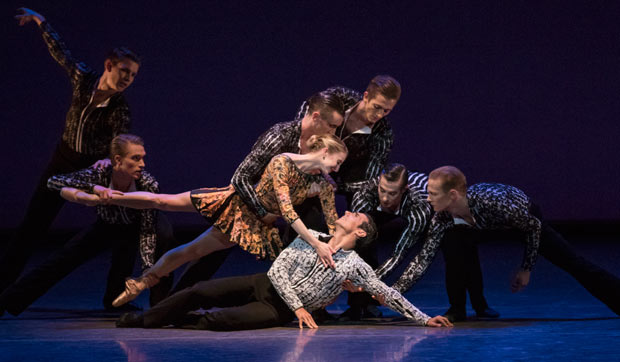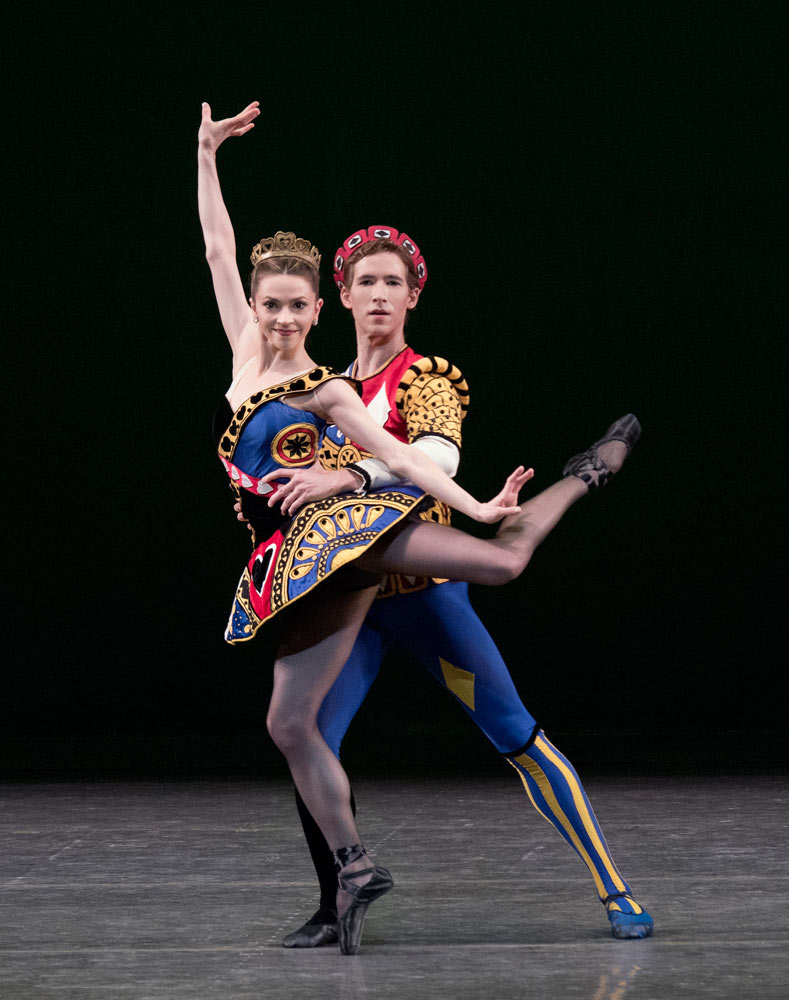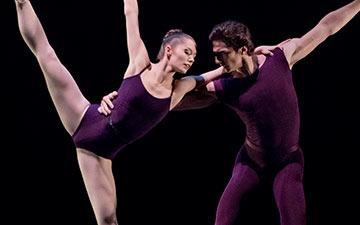
© Paul Kolnik. (Click image for larger version)
New York City Ballet
Spring Gala: Jeu de Cartes, After the Rain pdd, Tchaikovsky Pas de Deux, Odessa
★★★✰✰
New York, David H. Koch Theater
4 May 2017
www.nycballet.com
davidhkochtheater.com
With only four works, no intermissions and a run time of less than two hours, New York City Ballet’s Spring Gala was short and to the point. The Alexei Ratmansky world premiere, Odessa, closed the program, preventing any early exits, but only one work overstayed its welcome, Peter Martins’ Jeu de Cartes.
Odessa’s lasting impression is its mood, which is dark, and vaguely haunted. But the trick of memory is its cloaking mechanisms. For all of Odessa’s moodiness, it is punctuated by blaring bombast. This contrast comes from the music, Leonid Desyatnikov’s “Sketches to Sunset,” his incidental music to the 1990 Russian film, “Sunset,” – a film about Jewish gangsters in Odessa inspired by Isaac Babel stories. Tango is a big theme, and Ratmansky takes a cue here. Wearing torso-hugging shirts, the men exude virility taking strong stances and deep lunges, while the women are emotive but strong, though at times fickle, wearing rippling feminine dresses (the principals get shorter, flitty versions of the corps’ darker, heavier skirts).
Ratmansky technically avoids any official narrative, but Odessa exhibits clear signs of everything from heartbreak to unrequited love and unwanted advances. Love is thwarted, denied and occasionally reciprocated. This rummaging through various stages of lust and affection is an odd fit against the score which vacillates between the influences of tango and klezmer, although maybe the music’s unsettled nature is meant to reflect something of the lovers’ trials.

© Paul Kolnik. (Click image for larger version)
The score has a sinister air that is hard to escape. Tiler Peck is grappled against her will by Taylor Stanley in an exhausting struggle that ends with him carrying her off in his arms, any consent from her dubious at best. Joaquin De Luz – who shone brightest on Thursday night – pines for Sterling Hyltin who retreats repeatedly and then, who knows why or how, changes her mind and enjoys, nay encourages, his advances. Sara Mearns holds her course, smoldering in her tragedy mask. The liaisons and drama are interrupted by booming brass and dense corps work in folk-inspired ensemble.
In short, at least on the first pass, Odessa feels incidental, rather than a defining work in Ratmansky’s ever-growing oeuvre.

© Paul Kolnik. (Click image for larger version)
Christopher Wheeldon’s pas de deux from After the Rain is now a signature aria in contemporary ballet, so much so that seeing it on a program can make one’s eyes roll. Created by Wheeldon for Wendy Whelan and Jock Soto, Rain’s excerpted pas de deux has now been performed by countless dancers all over the world (San Francisco Ballet’s Yuan Yuan Tan’s interpretation can be transcendent). The score, Arvo Pärt’s piano and violin composition Spiegel im Spiegel conjures up tears and rain, the piano plodding plaintively as the violin plays your heartstrings.
I have never been able to decide whether After the Rain is a celebration or mourning of intimacy. The male choreography has always seemed more withholding than the female, featuring one handed lifts or embraces, while the female role repeatedly unfolds herself with legs or arms, completely open.

© Paul Kolnik. (Click image for larger version)
At Thursday night’s gala, Maria Kowroski performed the role with strength, allowing herself to be vulnerable but never weak, emanating a sense of power drawn from human closeness, whether it was ending or not. Her loose amber hair took on the role of a third character, sweeping across Ask la Cour’s bare chest as a reminder of the uniqueness of the private, tactile connection we reserve for lovers and not friends. Some of the lifts did not appear effortless, and the pas de deux was less sterile because of it, a reminder of love’s fragility no matter its age.
Ashley Bouder was a sunny smart aleck in Balanchine’s Tchaikovsky Pas de Deux, milking every balance for all it was worth and then some, but never off her music. It is the kind of playful sass one expects at a gala. While she was all razzmatazz, Andrew Veyette looked a bit worn, and nearly dropped her in the final leaping fish dive. The music, taken from the composer’s belated add-on to Swan Lake which was discarded by Petipa, still boasts hints of the tragic ballet’s darker tonalities but Balanchine’s zippy choreography overrides it.

© Paul Kolnik. (Click image for larger version)
Created in 1992 as part of the Diamond Project, Jeu de Cartes is Martins’ “abstract” reinvention of Balanchine’s original 1937 work set to Stravinsky’s eponymous commissioned score (created with M. Malaieff), wherein dancers act as cards in poker plays. In Balanchine’s version a joker takes the lead role, whereas in Martins’ it is the Queen of Hearts. Despite the difficulty in setting dance to this music, other choreographers have been drawn to it, including Ratmansky and John Cranko.

© Paul Kolnik. (Click image for larger version)
Clocking in at just over 20 minutes, Jeu de Cartes felt too long (and exhausting) for a gala program. Well before the end, mid-dance, Harrison Ball, the King of Spades, looked like he might outright collapse. New to the soloist roster, he danced with dignity but looked weak, winded and overtaxed. Megan Fairchild was a sprightly coquette, prancing en pointe tirelessly with a wry smile on her face. Over a dozen fresh faced corps members (including some apprentices) get a stamina workout, and for the most part they fared well, though several sections of Jeu de Cartes appeared under rehearsed.

















You must be logged in to post a comment.